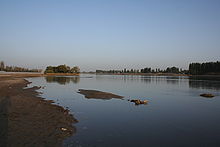Yanqi Hui Autonomous County
Kara Shahr, Yenki, Qarasheher, Karashahr | |
|---|---|
 Mosque in the city center of Yanqi | |
 Yanqi County (red) within Bayin'gholin Prefecture (yellow) and Xinjiang | |
| Coordinates: 42°03′35″N 86°34′27″E / 42.0598°N 86.5741°E | |
| Country | China |
| Autonomous region | Xinjiang |
| Autonomous prefecture | Bayin'gholin |
| County seat | Karasahr (Yanqi) |
| Area | |
| • Total | 2,429.2 km2 (937.9 sq mi) |
| Population (2020)[1] | |
| • Total | 122,961 |
| • Density | 51/km2 (130/sq mi) |
| Time zone | UTC+8 (China Standard[a]) |
| Website | www |
| Yanqi Hui Autonomous County | |||||||||||
|---|---|---|---|---|---|---|---|---|---|---|---|
 | |||||||||||
| Chinese name | |||||||||||
| Simplified Chinese | 焉耆回族自治县 | ||||||||||
| Traditional Chinese | 焉耆回族自治縣 | ||||||||||
| |||||||||||
| Uyghur name | |||||||||||
| Uyghur | يەنجى خۇيزۇ ئاپتونوم ناھىيىسى | ||||||||||
| |||||||||||
Yanqi Hui Autonomous County (Uyghur: Qarasheher, Karashahr) is an autonomous county in the Xinjiang Uyghur Autonomous Region and is under the administration of the Bayin'gholin Mongol Autonomous Prefecture. It has an area of 2,429 km2 (938 sq mi). According to the 2002 census, it has a population of 120,000. The Shikshin Buddhist Temple Ruins are located in Yanqi County, about 25–30 km (16–19 mi) southwest of the town of Yanqi.


